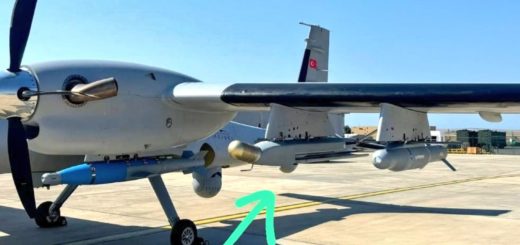Kratos Equips its Stealth Drone XQ-58 with Landing Gear to Enhance Deployment Flexibility and Reusability

{loadposition bannertop}
{loadposition sidebarpub}
On April 15, 2025, Kratos officially unveiled via its X (formerly Twitter) account a rendering of a new version of its XQ-58A Valkyrie stealth drone equipped with a retractable tricycle landing gear. This announcement marks a significant development in the Valkyrie program, which had so far prioritized operations fully independent of runways for both launch and recovery. The presentation of this conventional configuration reflects a clear intent by Kratos to broaden the operational options of the system for the U.S. armed forces, particularly within the scope of future phases of the U.S. Air Force’s Collaborative Combat Aircraft (CCA) program, and potentially the U.S. Navy.
Follow Army Recognition on Google News at this link
The Valkyrie may therefore appeal not only to the U.S. Air Force, but also to the U.S. Marine Corps, which continues development of its MUX-TacAir program aimed at supporting the F-35B in strike and intelligence roles. (Picture source: Kratos)
Originally designed to be launched using disposable boosters mounted on ground ramps and recovered by parachute, the XQ-58A was notable for its ability to operate without relying on airfield infrastructure, a key advantage in high-intensity conflicts or expeditionary deployments. Kratos had previously proposed a containerized launch system concept and, in 2024, introduced a trolley-based launch platform allowing operations from conventional runways. The model revealed in April 2025 constitutes the third launch-and-recovery method developed by the company, this time following a CTOL/HTOL (Conventional/Horizontal Take-Off and Landing) configuration.
The released visual shows a tricycle landing gear system, featuring a nose wheel and two main wheels, with integrated protective doors in the fuselage. The nose gear appears to retract forward behind two trapezoidal hatches, while the main gear legs fold laterally into bays beneath the fuselage. Aside from this new equipment, the airframe remains consistent with the original design. Kratos has not yet disclosed any technical specifications distinguishing this version from previous ones, such as maximum takeoff weight, speed, or range.
The integration of landing gear addresses a growing operational need for flexibility. When asked about the modification, Kratos told that converting runway-independent drones to CTOL/HTOL configurations was “technically” feasible, but the broader goal was to offer multiple Valkyrie variants to support a wider range of mission scenarios. According to Steve Fendley, President of Kratos’ Unmanned Systems Division, the addition of landing gear allows conventional take-off and landing while reducing internal payload volume, though without impacting external hardpoints.
This technical development also reflects a shift in industrial positioning. Although Kratos was not selected for the first increment of the CCA program—awarded to General Atomics with the YFQ-42A and Anduril with the YFQ-44A—the company remains engaged with upcoming increments, which are expected to introduce more stringent requirements and potentially reopen competition. The release of this rendering thus occurs in a strategic context in which Kratos seeks to reinforce its relevance in the collaborative combat drone segment. The Valkyrie may therefore appeal not only to the U.S. Air Force, but also to the U.S. Marine Corps, which continues development of its MUX-TacAir program aimed at supporting the F-35B in strike and intelligence roles.
Kratos has also confirmed that it is working on a version tailored to the Marines’ specific requirements, designated MQ-58B, which would include electronic warfare capabilities intended to suppress enemy air defenses. This version would enhance interoperability with short take-off and vertical landing (STOVL) F-35B aircraft, aligning with multi-domain naval air operations. The drone is already used in experimental contexts by the U.S. Air Force and Marine Corps as part of research, development, and concept validation efforts.
From a tactical standpoint, the introduction of landing gear brings operational advantages. Unlike previous configurations, the CTOL/HTOL model does not require rocket boosters for launch or parachutes for recovery, simplifying pre-flight procedures and enabling faster mission turnaround. Kratos had previously indicated that the trolley-based launch system increased fuel and payload capacity by several dozen percent, enhancing both endurance and range.
This new variant may also draw the interest of the U.S. Navy. Although the Navy is still defining the parameters of its own CCA requirements, it has shown interest in Boeing Australia’s MQ-28 Ghost Bat, developed with the Royal Australian Air Force, which could also be adapted into a carrier-capable variant with an arrestor hook. In 2021, the Navy had already requested concepts for operating XQ-58 drones from mobile maritime bases such as Expeditionary Sea Base ships, including potential variants with landing gear.
Kratos is also considering international markets for the Valkyrie, leveraging its experience with aerial target drones already delivered to foreign customers for training, testing, and technology development. The CTOL/HTOL configuration could open up further export opportunities, particularly among armed forces seeking a modular, semi-expendable, and lower-cost alternative to strategic drones.
the official unveiling of the XQ-58A equipped with landing gear reflects Kratos’ intent to align with the evolving requirements of collaborative air combat. This new variant expands the Valkyrie’s operational roles by combining runway-based deployment, reusability, and compatibility with U.S. force employment doctrines. Its adaptable architecture may enhance the system’s competitiveness in future CCA program phases and appeal to partner nations modernizing their combat drone fleets.

{loadposition bannertop}
{loadposition sidebarpub}
On April 15, 2025, Kratos officially unveiled via its X (formerly Twitter) account a rendering of a new version of its XQ-58A Valkyrie stealth drone equipped with a retractable tricycle landing gear. This announcement marks a significant development in the Valkyrie program, which had so far prioritized operations fully independent of runways for both launch and recovery. The presentation of this conventional configuration reflects a clear intent by Kratos to broaden the operational options of the system for the U.S. armed forces, particularly within the scope of future phases of the U.S. Air Force’s Collaborative Combat Aircraft (CCA) program, and potentially the U.S. Navy.
The Valkyrie may therefore appeal not only to the U.S. Air Force, but also to the U.S. Marine Corps, which continues development of its MUX-TacAir program aimed at supporting the F-35B in strike and intelligence roles. (Picture source: Kratos)
Originally designed to be launched using disposable boosters mounted on ground ramps and recovered by parachute, the XQ-58A was notable for its ability to operate without relying on airfield infrastructure, a key advantage in high-intensity conflicts or expeditionary deployments. Kratos had previously proposed a containerized launch system concept and, in 2024, introduced a trolley-based launch platform allowing operations from conventional runways. The model revealed in April 2025 constitutes the third launch-and-recovery method developed by the company, this time following a CTOL/HTOL (Conventional/Horizontal Take-Off and Landing) configuration.
The released visual shows a tricycle landing gear system, featuring a nose wheel and two main wheels, with integrated protective doors in the fuselage. The nose gear appears to retract forward behind two trapezoidal hatches, while the main gear legs fold laterally into bays beneath the fuselage. Aside from this new equipment, the airframe remains consistent with the original design. Kratos has not yet disclosed any technical specifications distinguishing this version from previous ones, such as maximum takeoff weight, speed, or range.
The integration of landing gear addresses a growing operational need for flexibility. When asked about the modification, Kratos told that converting runway-independent drones to CTOL/HTOL configurations was “technically” feasible, but the broader goal was to offer multiple Valkyrie variants to support a wider range of mission scenarios. According to Steve Fendley, President of Kratos’ Unmanned Systems Division, the addition of landing gear allows conventional take-off and landing while reducing internal payload volume, though without impacting external hardpoints.
This technical development also reflects a shift in industrial positioning. Although Kratos was not selected for the first increment of the CCA program—awarded to General Atomics with the YFQ-42A and Anduril with the YFQ-44A—the company remains engaged with upcoming increments, which are expected to introduce more stringent requirements and potentially reopen competition. The release of this rendering thus occurs in a strategic context in which Kratos seeks to reinforce its relevance in the collaborative combat drone segment. The Valkyrie may therefore appeal not only to the U.S. Air Force, but also to the U.S. Marine Corps, which continues development of its MUX-TacAir program aimed at supporting the F-35B in strike and intelligence roles.
Kratos has also confirmed that it is working on a version tailored to the Marines’ specific requirements, designated MQ-58B, which would include electronic warfare capabilities intended to suppress enemy air defenses. This version would enhance interoperability with short take-off and vertical landing (STOVL) F-35B aircraft, aligning with multi-domain naval air operations. The drone is already used in experimental contexts by the U.S. Air Force and Marine Corps as part of research, development, and concept validation efforts.
From a tactical standpoint, the introduction of landing gear brings operational advantages. Unlike previous configurations, the CTOL/HTOL model does not require rocket boosters for launch or parachutes for recovery, simplifying pre-flight procedures and enabling faster mission turnaround. Kratos had previously indicated that the trolley-based launch system increased fuel and payload capacity by several dozen percent, enhancing both endurance and range.
This new variant may also draw the interest of the U.S. Navy. Although the Navy is still defining the parameters of its own CCA requirements, it has shown interest in Boeing Australia’s MQ-28 Ghost Bat, developed with the Royal Australian Air Force, which could also be adapted into a carrier-capable variant with an arrestor hook. In 2021, the Navy had already requested concepts for operating XQ-58 drones from mobile maritime bases such as Expeditionary Sea Base ships, including potential variants with landing gear.
Kratos is also considering international markets for the Valkyrie, leveraging its experience with aerial target drones already delivered to foreign customers for training, testing, and technology development. The CTOL/HTOL configuration could open up further export opportunities, particularly among armed forces seeking a modular, semi-expendable, and lower-cost alternative to strategic drones.
the official unveiling of the XQ-58A equipped with landing gear reflects Kratos’ intent to align with the evolving requirements of collaborative air combat. This new variant expands the Valkyrie’s operational roles by combining runway-based deployment, reusability, and compatibility with U.S. force employment doctrines. Its adaptable architecture may enhance the system’s competitiveness in future CCA program phases and appeal to partner nations modernizing their combat drone fleets.





